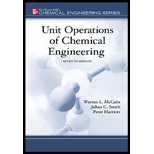
(a)
Interpretation:
The pipe dimensions are to be determined for flow of gas through pipeline.
Concept Introduction:
The fundamental concept of mass conservation is used to describe the fluid flow and determine the pipe dimensions. Here the material transporting through pipeline is natural gas and obeys the ideal-gas law.
(a)
Answer to Problem 8.1P
The cross-sectional radius of pipe is
Explanation of Solution
Given information:
The operating pressure of natural gas is
The operating temperature of natural gas is
Operational flow rate of natural gas is
Say, reference pressure of gas flow is
Calculation:
The actual flow rate of gas with respect to reference conditions is given by the following equation.
Here, the volumetric flow rate is given by
Substitute the value of known variables in the above expression.
Thus, the actual flow rate of natural gas with respect to given conditions is
Furthermore, the volumetric flow rate of fluids is given by the following equation.
Here,
Hence, the cross-sectional area is calculated as below.
The cross-section of pipeline is circular in appearance; hence, the area is that of a circle as shown below.
Here,
By simplifying the above equation, radius of pipeline can be simply calculated as below.
From the data available on dimensions, specifications and weights of schedule-40 steel pipes it is observed that the closest standard size available is 10 inch, which is also agreeable with the answer obtained above. Therefore, the inner radius of pipeline is
(b)
Interpretation:
The pipe dimensions are to be determined for transporting slurry into a centrifuge separator.
Concept Introduction:
Area of pipe depends on the volumetric flow rate of material. Conversely, volumetric flow rate depends on the mass flow rate and density of the material. In case of slurries, it is significant to have prior information about the mass fraction solid particles and solvents (such as water) to determine the physical properties.
(b)
Answer to Problem 8.1P
The radius of pipe under given condition is
Explanation of Solution
Given information:
The slurry transported through the pipeline contains solid crystals of p-nitrophenol and water. Let the total mass of slurry pushed into the centrifuge is
Mass of solid in slurry is
Density of p-Nitrophenol
Density of water
Mass flow rate of p-Nitrophenol
Calculation:
Mass flow rate of slurry
Here,
Mass flow rate of water
Volumetric flow rate
Volumetric flow rate
Therefore, the total volumetric mass flow rate of slurry
Thus, the actual flow rate of slurry is
Assume that the slurry velocity is
The, the area of pipeline can be obtained by the following relationship.
Here,
The radius
The radius of pipe to carry slurry of p-Nitrophenol and water under given condition is
Want to see more full solutions like this?
Chapter 8 Solutions
Unit Operations of Chemical Engineering
 Introduction to Chemical Engineering Thermodynami...Chemical EngineeringISBN:9781259696527Author:J.M. Smith Termodinamica en ingenieria quimica, Hendrick C Van Ness, Michael Abbott, Mark SwihartPublisher:McGraw-Hill Education
Introduction to Chemical Engineering Thermodynami...Chemical EngineeringISBN:9781259696527Author:J.M. Smith Termodinamica en ingenieria quimica, Hendrick C Van Ness, Michael Abbott, Mark SwihartPublisher:McGraw-Hill Education Elementary Principles of Chemical Processes, Bind...Chemical EngineeringISBN:9781118431221Author:Richard M. Felder, Ronald W. Rousseau, Lisa G. BullardPublisher:WILEY
Elementary Principles of Chemical Processes, Bind...Chemical EngineeringISBN:9781118431221Author:Richard M. Felder, Ronald W. Rousseau, Lisa G. BullardPublisher:WILEY Elements of Chemical Reaction Engineering (5th Ed...Chemical EngineeringISBN:9780133887518Author:H. Scott FoglerPublisher:Prentice Hall
Elements of Chemical Reaction Engineering (5th Ed...Chemical EngineeringISBN:9780133887518Author:H. Scott FoglerPublisher:Prentice Hall
 Industrial Plastics: Theory and ApplicationsChemical EngineeringISBN:9781285061238Author:Lokensgard, ErikPublisher:Delmar Cengage Learning
Industrial Plastics: Theory and ApplicationsChemical EngineeringISBN:9781285061238Author:Lokensgard, ErikPublisher:Delmar Cengage Learning Unit Operations of Chemical EngineeringChemical EngineeringISBN:9780072848236Author:Warren McCabe, Julian C. Smith, Peter HarriottPublisher:McGraw-Hill Companies, The
Unit Operations of Chemical EngineeringChemical EngineeringISBN:9780072848236Author:Warren McCabe, Julian C. Smith, Peter HarriottPublisher:McGraw-Hill Companies, The





